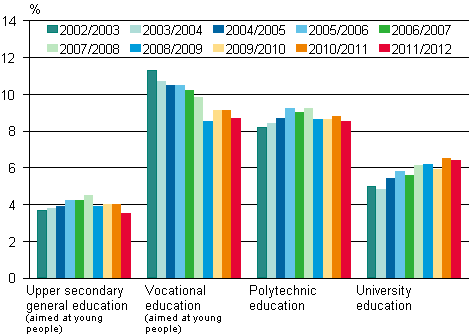Published: 20 March 2014
Discontinuation of education decreased
In all, 5.5 per cent of students attending education leading to a qualification or degree discontinued their studies and did not resume them in any education leading to a qualification or degree during the 2011/2012 academic year. In upper secondary general education, the discontinuation percentage was 3.5, in vocational education aimed at young people it was 8.7, in polytechnic education 8.5 and in university education 6.4 per cent. Discontinuation decreased compared to the previous year in all sectors of education, most in upper secondary general and vocational education. These data derive from Statistics Finland’s Education Statistics.
Discontinuation of education in upper secondary general, vocational, polytechnic and university education in academic years from 2002/2003 to 2011/2012, %

If students who have changed their sector of education, e.g. students who have switched from upper secondary general school to vocational education, are not calculated as discontinued students, the percentages of discontinuation are lower. Students in polytechnic education and in upper secondary general education changed their sector of education most frequently.
Of students aged 18 or over who discontinued upper secondary general school education, 46 per cent continued studies leading to a qualification or degree in some other sector of education, and 19 per cent transferred to work. The respective figures in vocational education were 10 and 30 per cent. Of students that discontinued polytechnic education, 25 per cent continued studies in some other sector of education and 53 per cent transferred to work. Of students that discontinued university education, 16 per cent transferred to some other sector of education leading to a qualification or degree, and 56 per cent started working. On the whole, students who discontinued education found employment slightly less easily than in the previous year. The employment data are based on the preliminary data of Statistics Finland's employment statistics from the end of 2012.
Men discontinued education more often than women, except for vocational education, which women discontinued more often than men. Education was discontinued most often in the field of natural sciences. Education was discontinued in relative terms the least in the field of social services, health and sports and in the field of other education, which includes such as fire and rescue training.
Discontinuation of education leading to a qualification or degree by sex and sector of education in academic year 2011/2012 1)
| Sex / sector of education | Number of students used in the statistics on discontinuation of education 20.9.2011 | Discontinued in own sector of education | Changed sector of education | Discontinued completely education leading to a qualification or degree | |
| % | % | % | |||
| Total | 502 762 | 7,0 | 1,4 | 5,5 | |
| Men and women | Upper secondary general education (aimed at young people) | 98 687 | 3,5 | 1,9 | 1,5 |
| Vocational education (aimed at young people) | 129 805 | 8,7 | 0,9 | 7,8 | |
| Polytechnic education (Bachelor’s degrees) | 130 683 | 8,5 | 2,0 | 6,4 | |
| University education (Bachelor’s and Master’s degrees) | 143 587 | 6,4 | 0,9 | 5,4 | |
| Men | Total | 238 676 | 7,6 | 1,3 | 6,3 |
| Upper secondary general education (aimed at young people) | 42 622 | 3,7 | 2,0 | 1,7 | |
| Vocational education (aimed at young people) | 68 436 | 8,3 | 0,6 | 7,7 | |
| Polytechnic education (Bachelor’s degrees) | 61 050 | 10,2 | 2,1 | 8,0 | |
| University education (Bachelor’s and Master’s degrees) | 66 568 | 7,2 | 1,0 | 6,2 | |
| Women | Total | 264 086 | 6,3 | 1,5 | 4,8 |
| Upper secondary general education (aimed at young people) | 56 065 | 3,3 | 1,9 | 1,3 | |
| Vocational education (aimed at young people) | 61 369 | 9,3 | 1,3 | 8,0 | |
| Polytechnic education (Bachelor’s degrees) | 69 633 | 7,0 | 1,9 | 5,0 | |
| University education (Bachelor’s and Master’s degrees) | 77 019 | 5,7 | 0,9 | 4,7 | |
Other statistics also indicate that studying was more interesting than in the year before. The pass rate improved in tertiary level education and employment during studies decreased. More information is available from statistics describing Progress of studies and Employment of students
In 2012, 875 students discontinued apprenticeship training during the four-month probationary period, which is 1.6 per cent of all students in apprenticeship training. In all, 4,030 students discontinued apprenticeship training after the probationary period, which is 7.3 per cent of all students in apprenticeship training. There were 55,554 students in apprenticeship training in 2012.
A total of 287 students had discontinued studies in one way or another in comprehensive school during the 2012/2013 academic year. The number of those who had completely dropped out from compulsory education in the spring term was 85 and those over the age of compulsory education having left school without a leaving certificate from comprehensive school was 202. More than one-half of school drop-outs were boys. The number of boys among those who had completely dropped out from compulsory education was 49, and 113 among those having left comprehensive school without a leaving certificate.
Source: Education. Statistics Finland
Inquiries: Riikka Rautanen 09 1734 2375, koulutustilastot@stat.fi
Director in charge: Riitta Harala
Publication in pdf-format (238.3 kB)
- Tables
-
Tables in databases
Pick the data you need into tables, view the data as graphs, or download the data for your use.
Appendix tables
Updated 20.3.2014
Official Statistics of Finland (OSF):
Discontinuation of education [e-publication].
ISSN=1798-9302. 2012. Helsinki: Statistics Finland [referred: 21.11.2024].
Access method: http://www.stat.fi/til/kkesk/2012/kkesk_2012_2014-03-20_tie_001_en.html

